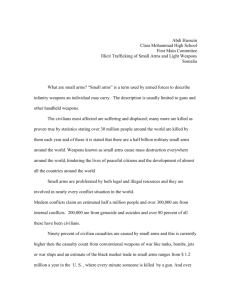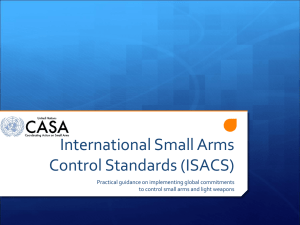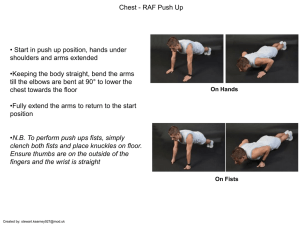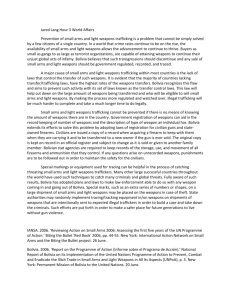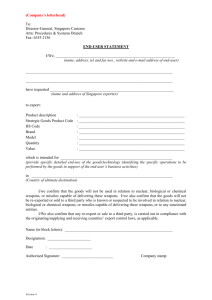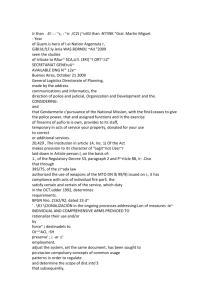INDIA - PoA-ISS
advertisement
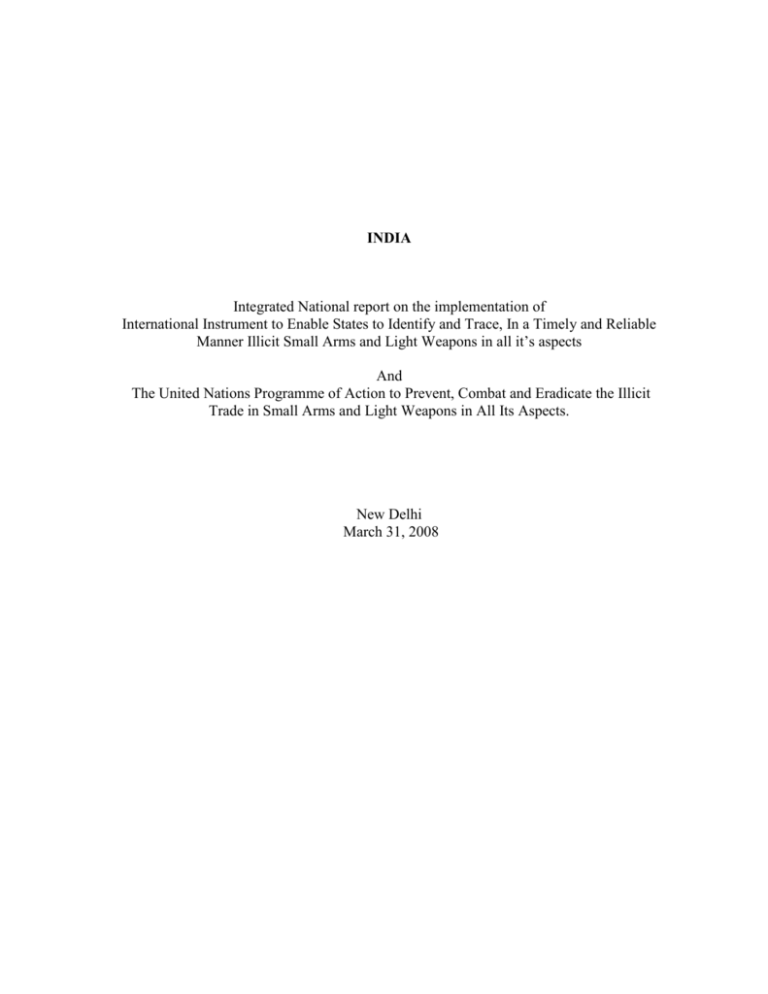
INDIA Integrated National report on the implementation of International Instrument to Enable States to Identify and Trace, In a Timely and Reliable Manner Illicit Small Arms and Light Weapons in all it’s aspects And The United Nations Programme of Action to Prevent, Combat and Eradicate the Illicit Trade in Small Arms and Light Weapons in All Its Aspects. New Delhi March 31, 2008 INTRODUCTION The Government of India believes that combating and eradicating illicit trade in Small Arms and Light Weapons (SALW) in all its aspects is a key element in global, regional and national security. It is also necessary for the social and economic development of many countries. India has supported international co-operation to achieve this goal multilaterally, regionally and bilaterally. The following is a report on Government of India’s policy and efforts to implement the International Tracing Instrument (ITI) and UN Programme of Action to Prevent, Combat and Eradicate the Illicit Trade in Small Arms and Light Weapons in All Its Aspects (UN PoA). The report is laid out in two chapters. National Point of Contact and Coordination Agency The office of Director, Disarmament and International Security Affairs Division, Ministry of External Affairs, Government of India, New Delhi is the national point of contact for international liaison on matters related to implementation of the ITI and UN PoA. The contact details are : (a) Telephone - 00-91-11-23011160 (b) Fax - 00-91-11-23015318 (c) E-Mail ID - g.dharmendra@mea.gov.in Government of India has set up an Inter-Ministerial Task Force in 2002 headed by Ministry of External Affairs whose members include representatives from the Ministries of External Affairs, Defence and Home Affairs and National Security Council Secretariat. The Task Force meets regularly to provide inputs related to policy guidance, research and monitoring of efforts to prevent, combat and eradicate the illicit trade in SALW. CHAPTER I : IMPLEMENTATION OF INTERNATIONAL TRACING INSTRUMENT Manufacture of Small Arms & Light Weapons The manufacture and production of SALW in India is fully controlled by Government of India. The manufacture of SALW is regulated under a licensing system established by the Arms Acts (1959) and Arms Rules (1962). Sections 5 and 7 of the Arms Act (1959) and Article 20 of Arms Rules (1962) prohibit the manufacture, transfer and repair of any SALW without a license. Through the licensing mechanism, Government of India is able to regulate the categories and types of weapons which may be manufactured and the transactions which may be carried out in their respect. SALW for armed forces/ police as well as for civilian use are primarily manufactured by Indian Ordnance Factories controlled by the Ministry of Defence. These factories are engaged in the manufacture of all categories of small arms. The policy of the Government of India for manufacture of arms and ammunition in the private sector is based on the Industry Policy Resolution, 1956. The private sector is primarily engaged in the manufacture of single and double-barrel and air rifles/ pistols. Even after liberalisation of the Indian economy and removal of licensing regime for major industries, the manufacture of arms like revolvers, pistols and rifled weapons – and ammunition thereof – has not been allowed in the private sector by the Government of India. 2 National Marking Practices (III) All small arms produced/ manufactured in India are uniquely marked. This applies to arms that are produced for private/ personal use and those which are used by armed forces, police or para-military forces. The Arms Act (1959) provides (Section 8) that arms which do not bear specified identification marks may not be sold or transferred. Further, under Arms Act (1959), any person found in possession of a weapon without identifications marks would be presumed to have removed/ obliterated the marks unless proven otherwise. The SALW produced by Indian ordnance factories are marked by stamping/ engraving or laser marking to indicate the type/ nomenclature of the weapon, ‘IN’ for India for country of origin, registration number, manufacturer/ factory of origin and the year of manufacture on one or more of the vital and critical components of a small arm - the body, the chamber, the cylinder, the breech block and the barrel – during the final stages of production. A record of each and every weapon manufactured by the factory is kept along with the information on the concerned dealer/ indenter to show receipts, disposal, balance of stock in hand and daily sales of Arms and Ammunition of different categories and provide such other information as may be required. Allotment of these registration numbers for the armed forces/ police and para-military forces is done centrally and a record is maintained of these registration numbers along with the indent. This provided for a double check on the records. Private sector manufacturers of firearms are required by law to get every firearm stamped to show: the maker’s name and registered trademark; the serial number of the weapons as entered in his register and the year of stamping; and proof-mark (Arms Rules (1959) Section 25). The parts of the weapons to be marked are also specified under these provisions. In order to implement the international instrument on marking and tracing of SALW, suitable instructions have now been given by the Government of India to the States to ensure that the country of origin ie word ‘IN’ is suitably marked on all arms manufactured by the private sector arms manufacturers. Further if an imported firearm kept for sale by a dealer does not bear the manufacturer’s name, the concerned importer is required to engrave appropriate Identification marks (identifying the importer), as allotted by the Government under these provisions (Section 25, Arms Rules (1962). The Magistrates and designated police officers are empowered under the Arms Rules to inspect the premises of arm manufacturing units, arms dealers, examine the stock and account of receipts and disposal of arms and ammunition or any other register or document. The Government of India has issued necessary instructions to all procurement agencies of the three Services not to import any small arms which do not have markings indicating country of origin. Towards this, it is proposed to introduce the following article in the Request for Proposals (RFP) which are issued for import of SALW :- 3 “In terms of para 8(a) of the International Instrument to enable States to identify and trace in a timely and reliable manner, illicit small arms and light weapons as adopted by the United Nations General Assembly on 8th December 2005, at the time of manufacture of each small arm or light weapon under their jurisdiction or control, the supplier shall ensure unique marking providing the name of the manufacturer, the country of manufacture and serial number or maintain any alternative unique user friendly marking with simple geometry symbols in combination with numeric and alpha numeric code, permitting ready identification by all. The manufacturers will confirm compliance with these provisions.” Record Keeping (IV) All ordnance factories maintain detailed records of small arms manufactured by them. Private firms and persons authorised to manufacture firearms against license issued under the Arms Rules of 1962 are required to maintain a Gun Manufacturing Register which records information including Serial Numbers and Date, Month and Year of manufacture. They are also required to maintain a Register of Rectification in which the Serial Numbers stamped on guns which are not passed by the Proof House on first submission are to be entered with a cross reference to the Gun Manufacturing Register. A designated Inspecting Officer inspects these registers regularly. According to existing laws (Arms Act of 1959, Section 3), a proper license is a prerequisite for possession of any SALW. District authorities may issue license after duly making police enquiries. Due to the gravity of the problem of proliferation of illicit SALW – and the onslaught of terrorism, Government of India has, since 1987, withdrawn substantially, the license issuing powers of State/ District authorities – who may not, now, issue license for prohibited bore weapons. Since 1987, their powers have been limited to issuing licenses for non-prohibited bore weapons and these licenses are valid for a limited geographical area. Under the existing law, all civilians are required to get their weapons/ inspected once a year by a competent authority – this is also recorded in the license. A record of arms sold in the civilian market (non-prohibited bore) is also required to be kept by each arms dealer under Section 26 of the Arms Rules (1962) in a Sale and Transfer Register. These records are regularly checked by the concerned state/ district authorities. License for possession of prohibited bore weapons may only be issued, under special conditions, by the Ministry of Home Affairs, Government of India, who also maintains a record of all such weapons in possession of civilian population. Licences for prohibitive bore weapons are issued by the Central Govt. in the case of a person having threat from terrorists/ anti social elements and to certain defence personnel who were allotted weapons during their tenure by Defence establishment. Armed forces/ police and para-military forces maintain a permanent record of all weapons in their possession. 4 CHAPTER 2 : IMPLEMENTATION OF PROGRAMME OF ACTION Implementation at National Level Provision of laws, regulations and administrative procedures/ Law enforcement (II.2, II.3, II.6) India’s domestic policy on SALW is regulated statutorily under the Arms Act (1959) and Arms Rules (1962), amended from time to time. These legislations and various executive instructions from Central and State governments have evolved a good mechanism for effective control and regulation of SALW in India. The Arms Act (1959) and Arms Rules (1962) cover all aspects of lawful possession, manufacture, sale, transfer, transport, export, import of arms and ammunition, and provide penal provisions for violation of these acts. The Arms Act (1959) and Arms. Rules (1962) are Central Government legislations and State Governments have a specified role in their implementation. The provisions of the Arms Act and Arms Rules seek to classify fire arms and other prohibitive weapons so as to ensure that (i) dangerous weapons of Military patterns are not available to civilians, particularly the anti-social elements and that (ii) weapons for self defence can be possessed by citizens in special cases only under duly issued licences. As per entry 5 of List 1 of the Seventh Schedule to the Constitution of India, the Central Government has the exclusive jurisdiction on matters relating to arms, firearms, ammunition and explosives. The Ministry of Home Affairs of the Indian Government administers the Arms Act and has taken all possible measures to arrest the proliferation and trafficking in small arms and light weapons. The violators of the provisions of the Arms Act are meted out punitive punishments as provided in the Arms Act which range from imprisonment with fine to death sentence. National Legislation/ Administrative Procedures Regulating Activities of Brokers involved in trade of SALW Rule 24 of Arms Rules 1962, permit the State Governments to grant licenses to the authorized selected dealers to sell or keep for sale arms and ammunitions. Licenses to such Arms Dealers are issued in the relevant Form of licenses viz. Form IX, XI and XII. Each license caries specific conditions, which are required to be followed by the arms dealers. The Government of India thus has a comprehensive and effective mechanism to control all aspects of small arms and light weapons in India. In addition to these, Government of India has also enacted several other laws which have penal provisions related to illegal possession, manufacture etc of SALW. These include Unlawful Activities (Prevention) Act 1967 as amended in September, 2004, Armed Forces (Special Powers) Act, Indian Penal Code, the Army Act and the analogous laws. A specific distinction in terms of caliber (prohibited and non-prohibited bore) exists as far as possession and trading in firearms by civilians is concerned. Prohibited bore weapons are those in use by security forces/ police and license for these are, as a rule, not issued to civilians. 5 Challenges of Illicit SALW in India India continues to face the challenge of proliferation of illicit SALW which are smuggled into the country by various anti-national groups. The seizures of illicit SALW, by security forces, from terrorists provide an indicative assessment of the problem they pose. In Jammu and Kashmir and the north eastern areas alone, the security forces have, since 1990, seized approximately 46,000 weapons of all types, whose markings clearly indicated that these were brought into India through illicit channels from outside the country. This continues to pose a significant challenge to the Government. In the last two years alone (2006-07), the number of illicit SALW seized or confiscated by security forces in Jammu and Kashmir and in the north eastern areas was approximately 3,953. The Government of India remains committed to taking all necessary measures to put an end to such illicit flows. At the same time, the government has also taken effective measures to ensure that the weapons confiscated/ seized by security/ police forces do not find their way back into illicit trade channels or fall into the hands of unscrupulous elements. A small amount of crude “countrymade” weapons are also found to be produced clandestinely in India. Updated tables listing the arms seized/ confiscated by security/ police forces in the last two years (2006 & upto October 2007) are at Annexure I and II respectively. Since almost all terrorist activities involve the use of illegal weapons, including small arms, organisations indulging in such activities are declared as “unlawful” under the provisions of relevant acts. A list of 32 organisations which have been banned by the Government under the Unlawful Activities (Prevention) Act 1967 as amended in 2004, for their activities is at Annexure III. State Stockpile Management and Security (II.10, II.17, II.18) The SALW held by the armed forces, police and other para-military forces are managed under a comprehensive system of regulations issued by Central and State Governments. The concerned government agency issues arms and ammunitions to armed forces, para-military forces and police as per the authorised scale and requirements. Under Chapter XX of the Defence Service Regulations (Regulations for the Army), specific and exhaustive provisions have been laid down for management and security of SALW held by the Army. These stocks are checked every quarter. Police arms and ammunition which have been classified as obsolete or unserviceable are earmarked for destruction before they are destroyed by the concerned State Police Forces at a central location under proper supervision. Disposal of seized and confiscated weapons (II.16) In the course of law enforcement activities – and operations against terrorists, Government authorities regularly seize/ confiscate weapons belonging to both “prohibited” and “non-prohibited” bore categories. Detailed instructions have been issued by the Government of India for disposal of such arms and ammunition. The main aim of the Government is to ensure that these weapons do not find their way back into the illicit trade channels or fall into the hands of unscrupulous elements. 6 Destruction of country-made weapons Country-made weapons seized during the special drives or in the course of implementation of the law, after they are no longer required for any judicial purposes, are mutilated/ defaced and are destroyed by the concerned State Police forces at a central location under proper supervision. Disposal of prohibited bore Small Arms Details of SALW which are seized/ confiscated by the police or para-military forces are sent to Ministry of Home Affairs after duly taking care of all the legal requirements. If required, in cases where the same type of weapons are already in use by the security forces – and for which spares would be available, the seized/ confiscated weapons are re-allocated to units of security forces for counter-terrorist operations. Other prohibited bore weapons seized by security forces are destroyed at the Central Ordinance Depot. Disposal of non-prohibited bore Small Arms Serviceable weapons of non-prohibited bore which are seized and confiscated by police or other law enforcement agencies may be disposed by allotment to eligible persons holding a valid license for such weapons. Such weapons are required to meet all the requirements laid out in the Arms Act (1959) in terms of having proper markings. The allotment is based on the realization of the price which is fixed by the Government. A monthly statement of all such seized stock is required to be sent to the Ministry of Home Affairs by the concerned State Police Department. All obsolete/unserviceable weapons and firearms and their components are destroyed. To ensure the security – and prevent misuse - of seized/confiscated weapons, a detailed inventory of these weapons in maintained in “seizure memos”. Such details include, inter-alia, the make and type of weapon. Their storage in local police stations is normally not allowed. These weapons are usually stored in a central location, such as in State Police Headquarters, so as to ensure their safety and proper supervision. Pending their disposal, a monthly statement of stocks of such weapons held by State Governments is sent to the Central Government (Ministry of Home Affairs). Export Controls (II.11, II.12, II.15) Export of all lethal items as well as other equipment and stores manufactured by Defence Public Sector Undertakings (DPSUs) and Indian Ordnance Factories (which includes SALWs) is governed by a regime administered by the Ministry of Defence in consultation with the Ministry of External Affairs. DPSUs and ordnance factories may export their items only on receipt of a ‘No-Objection Certificate’ (NOC) from the Department of Defence Production and Supplies, Ministry of Defence. The grant of an NOC is subject, inter alia, to an end-user certificate-on a government-to-government basis-and to conformity with foreign policy objectives-which includes a ban on exports to countries under UN embargo. 7 In addition, provisions of the Arms Act (1959) and Arms Rules (1962) have very stringent provisions governing the export and import of small arms. Section 10 of the Arms Act (1959) requires that any one intending to engage in export/ import of arms should first acquire the requisite license. Furthermore, license for export is not granted for automatic weapons and weapons which are in use by the police or armed forces of the country, weapons of “current and popular bore” (Section 33, Arms Rules (1962)) for which ammunition is available domestically, and certain antique weapons. Similarly import of arms by individuals or commercial entities is permitted only against a license. Such imports are, as a rule, allowed only to renowned shooters/ rifle clubs for their own use on the recommendation of the concerned Government Department. Furthermore, under the “Exim Policy 2002-2007”, transfer of the imported firearm/s is not permitted during the lifetime of the importer/ licensee. Global and Regional level India recognizes that close international co-operation is required to prevent, combat and eradicate the illicit trade in SALW. To this end, India has supported the efforts of international organisations and the initiatives taken under UN auspices. India has already supplied copies of its domestic legislation to UN DDA (II.23) International instrument against terrorism and trans-national organised crime (II.38) India has been a victim of cross-border terrorism for over two decades. India unequivocally condemns terrorism in all its forms and manifestations and strongly believes that there can be no justification, whatsoever, for any act of terrorism. The international community must have a policy of zero tolerance on terrorism and make further concerted efforts to fight this scourge. We must ensure that the issue is not obfuscated by efforts of some to veer the discussion towards so called “root causes of terrorism”. India is a party to all the thirteen sectoral UN Conventions on terrorism. India is fully committed to fulfilling its obligations under the various Security Council resolutions on counter terrorism, including UNSCR 1373. Government of India (GoI) has submitted five national reports to UNSC’s Counter Terrorism Committee in compliance with UNSCR 1373. GoI had accepted a proposal by the UN authorities for a visit by a 14-member delegation of UN Counter-Terrorism experts, led by Executive Director of UNSC’s Counter Terrorism Executive Directorate (CTED) and included representatives of CTED, Monitoring Team of UNSC’s 1267 Committee related to Al Qaeda/Taliban, INTERPOL, United Nations’ Office on Drugs and Crime (UNDOC) and World Customs Organisation (WCO). Besides giving first hand information to the delegation on GoI’s compliance of Security Council resolutions on counter terrorism, the visit provided a very useful opportunity to both sides for comprehensive discussions in this area. 8 India had introduced a draft Comprehensive Convention on International Terrorism (CCIT) at the United Nations as far back as 1996. India remains constructively engaged with other member states with the objective of an expeditious finalization of CCIT. India has also supported the UN Global CTS and the Plan of Action, adopted by member states on 8 September, 2006. India is firmly of the view that an early conclusion of the CCIT is imperative to any consolidation of counter terrorism efforts within the UN. As mentioned earlier, India has a very strict export policy for SALW to ensure effective implementation of UN arms embargoes (II.32) International cooperation to combat illicit trade in SALW Considering that the illicit trade in SALW is closely linked with terrorism, illicit drug trafficking, money laundering and other trans-national organised crimes, India has taken bilateral initiatives with a number of countries to put in place arrangements which would help combat the illicit trade in SALW (II.27). The agreements aim at enhancing cooperation in combating organized crime and international terrorism. They provide for exchange of documentation, information and experience on the activities of persons involved in organized crime and terrorism, including, inter-alia, illicit trade in arms, and funding of international terrorism. Most recently, India signed a MoU with Italy on Combating International Terrorism and Transnational Crime (February 2007). India has so far entered into agreement with 25 countries to set-up Joint Working Groups on combating terrorism and transnational crime. At the regional level, India along with other member states of BIMSTEC (Bay of Bengal Initiative for Multi-Sectoral Technical and Economic Cooperation) have established a Joint Working Group to coordinate efforts in areas such as intelligence sharing and capacity building as well as to strengthen joint efforts on counter terrorism and trans-national crime. The Joint Working Group has had three meetings so far with the last meeting having been held in Nay Pyi Taw, Myanmar in January 2007. Similarly, India has a Joint Working Group arrangement with European Union (EU). India has been actively associated with various workshops and seminars that have been organized either under UN auspices or by other interested parties to further effective international cooperation on this important subject. India attended a workshop on SALW held in Tokyo on 12-13 March 2007. One officer from the Indian Army attended ARF Workshop on SALW at Phnomh Penh, Combodia from 13-14 December 2007 and gave a presentation on stock piles security and reducing surplus small arms and light weapons including ammunition. Annexure I STATE/ARMS WISE RECOVERED / SEIZED FIREARMS FOR THE YEAR 2006 1 2 3 1 2 3 1 1 28 1 1 33 1 7 2 1 2 49 1 62 27 57 1 3 4 5 4 2 6 1 1 0 2 59 0 1 2 0 132 48 113 1 Unnumbered weapons – Do not have identification number. 17 28 1 21 4 77 1 22 23 10 2 1 1 352 973 3 3 15 45 32 2 1 6 1 26 1 3 6 3 14 2 1 10 1 2 3 5 606 4 47 450 591 1626 2725 0 202 8 190 65 5 NR 0 6 1001 4 196 306 0 1572 NR 41 57 0 1219 425 94 38 8 34 84 0 144 851 3 56 99 49 937 1838 9532 COMBINED TOTAL 77 Total Unnumbered Other Firearms** Tamancha 2 1 0 47 18 15 17 3 1 3 0 1 36 77 33 14 9 36 6 21 5 0 NR 0 2 4 0 4 428 369 178 20 7 3 1 0 54 30 33 3 6 57 5 209 6 1 0 2 2 241 2 483 NR 25 7 9 5 36 1 1 13 0 0 897 76 92 0 113 47 242 90 33 2 54 3 0 8 6 16 3 6 1 2 1 4 20 2 33 38 12 1 0 8 108 23 47 275 293 74 3 194 2 1 0 1 49 3 3 1 1 72 11 4 2 1 2 265 18 454 4 8 14 1 1 9 41 157 16 1 5 3 1 940 794 1665 833 1696 622 *Other Firearms - Having no specific type of Firearms 3 Rifle 1 Revolver 1 Pistol 6 Katta 3 10 Gun CM 1 Total Numbered 3 4 Other Firearms* 6 Sten Gun 1 SL Rifle 2 Shot Gun DBBL Shot Gun SBBL Rifle Pipe Gun Musket Mouzer Revolver 3 1 Gun SBML Gun SBBL Gun FM Gun DBML Gun DBBL Grenade Carbine AK 74 A&N Islands Andhra Pradesh 3 2 Arunachal Pradesh Assam 2 1 Bihar 1 5 Chandigarh Chattisgarh D&N Haveli Daman & Diu Delhi Goa Gujarat Haryana Himachal Pradesh Jammu & Kashmir 449 34 Jharkhand Karnataka 1 Kerala Lakshadweep Madhya Pradesh Maharashtra Manipur Meghalaya Mizoram Nagaland Orissa Pondicherry Punjab 5 Rajasthan 2 Sikkim Tamil Nadu Tripura Uttar Pradesh 2 3 60 Uttranchal 2 West Bengal TOTAL 455 36 0 6 0 75 Note : Numbered weapons – Have identification number; NR – Data Not Received UNNUMBERED WEAPONS Pistol 1. 2. 3. 4. 5. 6. 7. 8. 9. 10. 11. 12. 13. 14. 15. 16. 17. 18. 19. 20. 21. 22. 23. 24. 25. 26. 27. 28. 29. 30. 31. 32. 33. 34. 35. AK 56 NUMBERED WEAPONS Knife State AK 47 Sl. No. 0 219 8 204 86 5 NR 0 6 1008 4 199 307 0 2055 NR 46 57 0 1219 458 94 41 10 36 85 0 191 854 3 57 101 314 951 1854 10472 Annexure II STATE/ARMS WISE RECOVERED / SEIZED FIREARMS IN 2007 till October 17 3 1 1 1 1 1 2 1 1 1 1 2 2 2 1 1 1 5 2 1 3 7 2 2 2 1 1 2 1 1 18 33 20 15 2 8 1 6 2 1 1 5 5 4 27 1 1 0 0 84 29 32 0 Unnumbered weapons – Do not have identification number. 4 1 2 1 0 1 *Other Firearms - 0 26 16 7 0 0 33 123 36 31 4 101 2 1 6 2 0 1 0 0 8 451 251 104 38 2 1 1 0 64 8 46 46 3 4 15 2 205 10 1 0 4 6 126 4 27 0 7 4 3 2 23 82 4 11 3 0 78 676 51 40 2 33 181 74 10 4 59 2 2 4 2 10 3 6 8 4 2 9 1 0 0 0 1 15 3 14 348 179 64 7 211 1 0 27 2 1 46 12 16 2 128 20 305 3 6 21 20 37 69 10 276 626 1512 640 1285 445 Having no specific type of Firearms 46 4 10 17 17 1 1 40 1 24 388 328 1 5 164 17 27 24 1 2 30 174 5 4 3 2 9 8 3 3 3 2 553 379 431 997 1792 0 95 NR 255 128 6 NR 2 0 853 2 205 260 0 856 NR 19 285 0 892 489 94 20 18 16 NR 0 19 819 1 29 80 0 716 1125 7284 COMBINED TOTAL 11 Total Unnumbered 25 Other Firearms* Tamancha Revolver Pistol Katta Gun CM Total Numbered Other Firearms* Sten Gun SL Rifle Shot Gun DBBL Shot Gun SBBL Rifle Revolver Pistol Pipe Gun Musket Mouzer Gun SBML Gun SBBL Gun FM Gun DBML Gun DBBL Grenade Carbine AK 74 A&N Islands Andhra Pradesh Arunachal Pradesh Assam 7 1 1 Bihar Chandigarh 1 1 Chattisgarh D&N Haveli Daman & Diu Delhi Goa Gujarat Haryana Himachal Pradesh Jammu & Kashmir 16 10 Jharkhand Karnataka 1 Kerala 1 Lakshadweep Madhya Pradesh 1 Maharashtra Manipur Meghalaya Mizoram 1 Nagaland Orissa Pondicherry Punjab 4 Rajasthan 1 Sikkim Tamil Nadu Tripura 1 Uttar Pradesh 1 37 Uttarakhand 4 West Bengal TOTAL 18 18 0 2 0 51 Note : Numbered weapons – Have identification number; NR – Data Not Received UNNUMBERED WEAPONS Rifle 1. 2. 3. 4. 5. 6. 7. 8. 9. 10. 11. 12. 13. 14. 15. 16. 17. 18. 19. 20. 21. 22. 23. 24. 25. 26. 27. 28. 29. 30. 31. 32. 33. 34. 35. AK 56 NUMBERED WEAPONS Knife State AK 47 Sl. No. 0 95 NR 286 129 8 NR 2 0 855 2 208 261 0 883 NR 21 288 0 894 499 96 23 22 16 NR 0 33 826 1 30 82 128 737 1135 7560 Annexure III ORGANISATIONS DECLARED AS TERRORIST ORGANISATIONS UNDER UNLAWFUL ACTIVITIES (PREVENTION) ACT, 1967 AS AMENDED IN 2004 1. 2. 3. 4. 5. 6. 7. 8. 9. 10. 11. 12. 13. 14. 15. 16. 17. 18. 19. 20. 21. 22. 23. 24. 25. 26. 27. 28. 29. 30. 31. 32. Babbar Khalsa International. Khalistan Commando Force. Khalistan Zindabad Force. International Sikh Youth Federation. Lashkar-e-Taiba/ Pasban-e-Ahile Hadis. Jaish-e-Mohammed/ Tahrik-e-Furqan. Harkat-ul-Mujahideen/ Harkat-ul-Ansar/Katkat-ul-Jehad-e-Islami. Hizb-ul-Mujahideen/ Hizb-ul-Mujahideen Pir Panjal Regiment. Al-Umar-Mujahideen. Jammu and Kashmir Islamic Front. United Liberation Front of Assam (ULFA). National Democratic Front of Bodoland (NDFB). People’s Liberation Army (PLA). United National Liberation Front (UNLF). People’s Revolutionary Party of Kangleipak (PREPAK). Kangleipak Communist Party (KCP). Kanglei Yaol Kanba Lup (KYKL). Manipur People’s Liberation Front (MPLF). All Tripura Tiger Force. National Liberation Front of Tripura. Liberation Tigers of Tamil Eelam (LTTE). Students Islamic Movement of India (SIMI). Deendar Anjuman. Communist Party of India (Marxist-Leninist)-People’s War, all its Formations and Front Organisations. Maoist Communist Centre (MCC), all its Formations and Front Organisations. Al Badr. Jamiat-ul-Mujahideen. Al-Qaida. Dukhtaran-e-Millat (DEM). Tamil Nadu Liberation Army (TNLA). Tamil National Retrieval Troops (TNRT). Akhil Bharat Nepali Ekta Samaj (ABNES).

